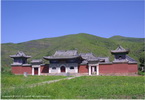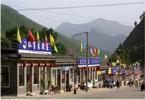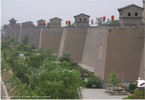|
WUTHAI SHAN (Mount Wuthai) |
|
|
 |
Guanyin cave
观音洞 |
|
GPS: |
38.98834, 113.59215 |
|
N/A |
xxxxxxxxxxxxxxxxxxxxxxxx |
|
|
|
|
|
 |
Qifo
temple (Seven Buddha Temple)
七佛寺 |
|
GPS: |
39.01776,
113.5998 |
|
N/A |
|
|
|
|
|
|
 |
Bishan temple (Guangji
Maopeng) 碧山寺 |
|
GPS: |
39.02273, 113.60138 |
|
Bìshān Temple is Wutai Shan's
largest shífāng chánsi: Buddhist
monks of any denomination are
welcome to stay and eat here for
free. The austere complex dates
from the 5th century, but was
considerably added to during the
Ming dynasty. An interesting
feature is the precept platform
called 'abstinence altar' where
Buddhist precepts are formally
kept and received. Here too lies
one the temple's most precious
donations – a Buddha statue of
white Burmese jade. |
|
|
|
|
|
|
 |
Jifu
temple |
|
GPS: |
39.022,
113.59567 |
|
N/A |
|
|
|
|
|
|
 |
Sanquan Shouning temple
寿宁寺 |
|
GPS: |
39.01527,
113.58755 |
|
Sanquan Temple, on the hillside
of Mount Wutai and near the town
of Taihuai gets its name from
the three ever-bubbling springs
in a well beside the temple.
Built in Yuan Dynasty
(1271-1368), the temple was
reconstructed by Master Xinglian
during the period of Ming
Zhengtong (1436-1449). Master
Xinglian rebuilt the nave and
cast a bronze statue of Buddha,
enshrined on the lotus stage in
the nave. During 1725 to 1734, a
Shananism Lama renovated the
temple again. |
|
|
|
|
|
|
 |
Cifu
temple 慈福寺 |
|
GPS: |
39.01742,
113.59262 |
|
This temple, also known as
Chantang (Meditation Hall) Yard,
is on the lower section of a
shady slope to the south of the
mouth of the Zixia Valley and at
the back of Pusa Ding
(Bodhisattva Top). |
|
|
|
|
|
|
 |
Longquan temple (Dragon Spring
Temple)
龙泉寺 |
|
GPS: |
38.9967, 113.54825 |
|
Dragon Spring Temple or
Longquan-si was named
after the spring found near the
site, and as it is situated at
the mid ranges of Mountain
Jiulong-Gang, it is also known
as Nine-Dragon Ridge . The
Temple was first built in Song
Dynasty (1254-1324), restored in
Ming (1368-1644) and expanded
during late Qing Dynasty in late
20th century. It was originally
an Ancestral temple for family
of General Yang. |
|
|
|
|
 |
Zhenhai
temple
镇海寺 |
|
GPS: |
38.9733,
113.57242 |
|
The centrepiece of this temple,
5km from Taihuai, is a striking
9m-tall Tibetan stupa where the
3rd Changkya Khutukhtu is
buried. The Changkya Khutukhtu
is a tulku or in Chinese, a
huófó (活佛), a reincarnate
custodian of a lineage of
teachings in Tibetan Buddhism;
the Dalai Lama is also a tulku.
Also worth noting are the three
statues of the Shakyamuni
Trinity in the main hall – all
in the form of men sporting
black facial hair. |
|
|
|
|
|
|
 |
Mingyue Pool
明月池 |
|
GPS: |
38.96602,
113.58051 |
|
N/A |
|
|
|
|
|
|
 |
Shancai
temple 善财洞 |
|
GPS: |
39.01012,
113.60149 |
|
N/A |
|
|
|
|
|
|
 |
Taihuai village
台怀镇 |
|
GPS: |
39.00138, 113.59451 |
|
There are more than thirty
Buddhist temples in this town,
including Jinge Temple, Mimi
Temple, Xiantong Temple, Tayuan
Temple, Wanfo Pavilion, Luohou
Temple, Yuanzhao Temple,
Guangzong Temple, Pusading, Cifu
Temple, Shuxiang Temple,
Longquan Temple, Zhenhai Temple,
Nanshan Temple, Bishan Temple,
Lingfeng Temple, Shouning
Temple, Guangren Temple, Puhua
Temple, Santa Temple, Qifu
Temple, Guanghua Temple, Fanxian
Temple, Jifu Temple, Pushou
Temple, Jixiang Temple, Wuye
Temple, and Mingyue Chi. |
|
|
|
|
|
|
 |
Wuthaisan
montain |
|
GPS: |
39.00761,
113.59627 |
|
Representing a manifestation of
Manjushri, Mount Wutai is one of
the Four Sacred Buddhist
Mountains of China, along with
Mt. Emei, Mt. Jiuhuashan and Mt.
Putuoshan. It takes its name
from its unusual topography,
consisting of five rounded
treeless peaks of North, South,
East, West and Central. With
such a spectacular formation and
integration of many ancient
temples tracing back to Tang
dynasty, it was listed as World
Heritage Site in 2009. |

 |
|
|
|
|
|
|
DATONG area |
|
|
|
 |
Datong Yungang Grottoes
大同云冈石窟 |
|
GPS: |
40.1119, 113.13237 |
|
Known as one of China’s three
major cave clusters, the Yungang
Grottoes embody the beauty of
Buddhist cave art, representing
the peak of Buddhist cave
carving in China’s history.
Preserved as a UNESCO World
Heritage site, the 252 caves
containing more than 51,000
statues and relics were first
carved in 450 at the height of
the Northern Wei Dynasty
(386-584). |


 |
|
|
|
 |
Nine-Dragon Screen
大同九龙壁 |
|
GPS: |
40.09298,
113.30355 |
|
The Datong Nine-Dragon Screen
Wall was built at the start of
the Ming Dynasty (1368).45.5
meters long, 8 meters high, and
2.02 meters thick.As one of the
three famous walls of this style
in China, the Datong Nine-Dragon
Wall is the oldest, largest, and
most enchanting one. |
 |
|
|
|
|
|
 |
Wooden Pagoda (Pagoda of Fogong
Temple)
佛宫寺释迦塔 |
|
GPS: |
39.56489,
113.18906 |
|
The Sakyamuni Pagoda of Fogong
Temple of Ying County, Shanxi
province, China, is a wooden
Chinese pagoda built in 1056,
during the Khitan-led Liao
Dynasty. The pagoda was built by
Emperor Daozong of Liao at the
site of his grandmother's family
home.The pagoda stands on a 4 m
(13 ft) tall stone platform, has
a 10 m (33 ft) tall steeple, and
reaches a total height of 67.31
m (220.83 ft) tall; it is the
oldest existent fully wooden
pagoda still standing in China. |
 |
|
|
|
|
|
 |
Temple |
|
GPS: |
na |
|
N/A |
|
|
|
|
|
|
 |
Hanging Monastery (Xuankong Si)
悬空寺 |
|
GPS: |
39.65817, 113.71231 |
|
The Hanging Monastery was built
in year 491 so it’s now more
than 1500years old, and still
standing tall 75 meters (246
feet) above ground. The
Monastery was originally built
without the wooden pillars,
that’s supporting the buildings.
But they were added later for
security measures. The pillars
are actually moveable and can be
taken away without the Monastery
falling off the cliff. |
 |
|
|
|
|
|
 |
Datong
City 大同市 |
|
GPS: |
40.07676,
113.30012 |
|
Today’s Datong is a third-tier
city of 3.3 million people, with
a vastly expanded urban area of
almost 50 square kilometres. In
recent decades, mass and
indiscriminate rebuilding,
alongside a booming coal mining
industry that gained Datong the
label “China’s capital of coal”. |
 |
|
|
|
|
|
|
TAIYUAN area |
|
|
 |
Tianlongshan Grottoes
天龙山石窟 |
|
GPS: |
37.73605,
112.38543 |
|
Tianlongshan Grottoes is a
series of 24 caves carved into
the mountainside of Tianlong
Mountain and well known among
Chinese art experts for the fine
Buddhist statues and decorations
which were sculpted within. The
24 caves were carved in Eastern
Wei, Northern Qi, Sui, and Tang
Dynasties. Grottoes 2 and 3 are
the oldest in the complex, with
a history of nearly 1,500 years. |
|
|
|
|
|
|
 |
Jinci Temple
晉祠 |
|
GPS: |
37.70683, 112.44521 |
|
The Jinci or Jin Temple is the
most prominent temple complex in
Shanxi. It is located 25 km
southwest of Taiyuan at the foot
of Xuanweng Mountain at the Jin
Springs. It was founded about
1,400 years ago and expanded
during the following centuries,
resulting in a diverse
collection of more than 100
sculptures, buildings, terraces,
and bridges. |

|
|
|
|
|
|
|
PINGYAO area |
|
|
 |
Pingyao
Ancient City
平遥古城 |
|
GPS: |
37.20436,
112.17569 |
|
Pingyao is a small,
well-preserved, ‘ancient city’,
famed for centuries-old
architecture and China’s first
bank. It is an outstanding Han
Chinese city of the Ming and
Qing dynasties that has retained
its historic features to an
exceptional degree. |
 |
|
|
|
|
|
 |
Shuanglin
Temple 双林寺 |
|
GPS: |
37.17071,
112.13159 |
|
The Shuanglin Temple is among
the many cultural monuments
located in the Pingyao, which is
a UNESCO World Heritage site
inscribed in 1997. Founded in
the 6th century, the temple is
notable for its collection of
more than 2,000 decorated clay
statues that are dated to the
12th-19th centuries. Its
original name was Zongdu but it
was renamed during the Northern
Song Dynasty period as
Shuanglin. |

 |
|
|
|
|
|
|
OTHERS |
|
|
 |
Shanxi
Countryside |
|
GPS: |
na |
|
N/A |
|
|
|
|
|
|
 |
Great
Wall Shanxi |
|
GPS: |
na |
Basic Facts of the Shanxi Great
Wall
In Shanxi Province, more
than 3,541 kilometers of the
Great Wall were built in ancient
times and now the best preserved
sections stretch approximately
1,497 kilometers, and are
distributed across nine cities
and over 40 counties. |
 |
|
|
|
|
|
|

































